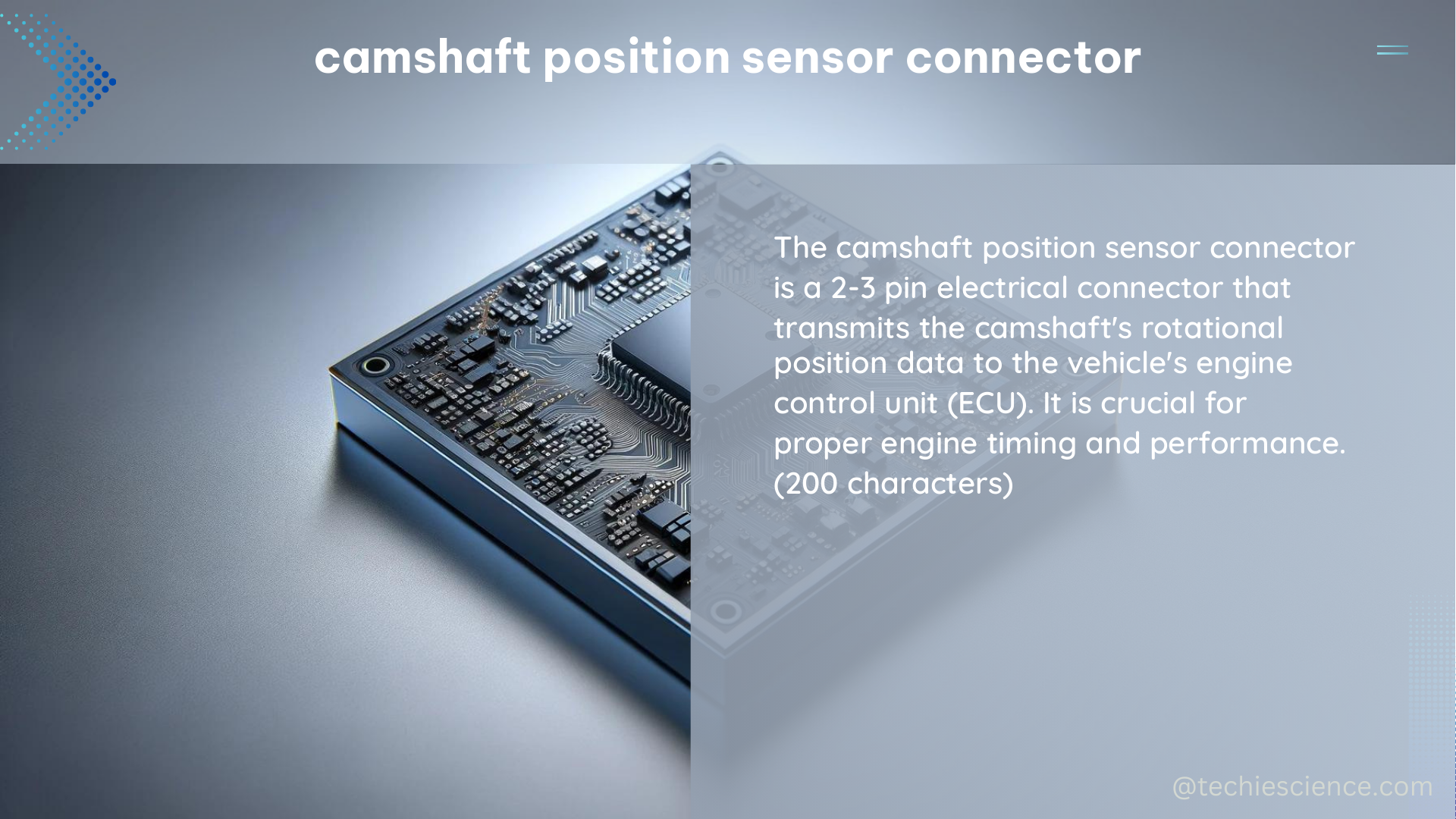The camshaft position sensor connector is a critical component in modern vehicles, responsible for transmitting crucial data about the engine’s operation to the engine control unit (ECU). This data is used to control various aspects of the engine’s operation, including fuel injection, ignition timing, and engine management.
Understanding the Camshaft Position Sensor Connector
The camshaft position sensor connector is typically a multi-pin connector that is attached to the camshaft position sensor. The sensor itself is usually a Hall effect sensor or a variable reluctance sensor, which generates a voltage signal as the camshaft rotates. This signal is transmitted to the ECU via the connector, where it is used to determine the position of the camshaft and, by extension, the position of the pistons within the engine.
The technical specifications of the camshaft position sensor connector can vary depending on the make and model of the vehicle. However, some common specifications include:
| Specification | Range |
|---|---|
| Voltage Range | 0-5 volts |
| Frequency Range | 1-10 kHz |
| Maximum Current Draw | 50 mA |
The connector itself is typically a sealed unit, designed to protect the sensitive electronics within from moisture, dust, and other contaminants. This ensures reliable and consistent data transmission, which is crucial for the proper operation of the engine.
Diagnosing Camshaft Position Sensor Connector Issues

Camshaft position sensor connector issues can manifest in various ways, including:
-
Engine Misfiring: If the camshaft position sensor connector is not functioning correctly, the ECU may not receive accurate information about the position of the camshaft, leading to improper fuel injection and ignition timing, resulting in engine misfiring.
-
Check Engine Light Illumination: A problem with the camshaft position sensor connector will often trigger a diagnostic trouble code (DTC) in the ECU, causing the check engine light to illuminate on the dashboard.
-
Rough Idling or Stalling: Inaccurate camshaft position data can cause the engine to run rough or stall, especially at idle or low speeds.
-
Reduced Fuel Efficiency: Improper engine management due to camshaft position sensor connector issues can lead to increased fuel consumption and reduced overall fuel efficiency.
To diagnose camshaft position sensor connector issues, you can use a diagnostic scan tool to read any DTCs stored in the ECU. Additionally, you can perform a visual inspection of the connector for signs of damage, corrosion, or loose connections.
Replacing the Camshaft Position Sensor Connector
Replacing a camshaft position sensor connector can be a challenging task, requiring a certain level of mechanical and electrical expertise. However, with the right tools and a clear understanding of the process, it is possible to complete the task successfully. Here are the steps to replace a camshaft position sensor connector:
-
Locate the Camshaft Position Sensor: The camshaft position sensor is typically located near the camshaft, often on the cylinder head or near the timing cover. Consult your vehicle’s service manual for the exact location.
-
Disconnect the Electrical Connector: The electrical connector for the camshaft position sensor is typically a multi-pin connector that can be disconnected by pressing the tab on the connector and pulling it away from the sensor.
-
Remove the Old Sensor: The camshaft position sensor is typically held in place by one or more bolts. Remove these bolts and carefully pull the sensor out of the engine.
-
Install the New Sensor: Install the new sensor in the reverse order of the removal process. Be sure to tighten the bolts to the specified torque, which can typically range from 8-12 Nm (6-9 ft-lb).
-
Reconnect the Electrical Connector: Reconnect the electrical connector to the new sensor, ensuring that it is securely attached.
-
Test the System: Start the engine and use a scan tool to verify that the camshaft position sensor is working properly. Check for any diagnostic trouble codes and clear them if necessary.
It’s important to note that the camshaft position sensor connector is a critical component, and any issues with it can have a significant impact on the engine’s performance and fuel efficiency. If you are unsure about your ability to replace the connector, it is recommended to have a professional mechanic perform the task.
Conclusion
The camshaft position sensor connector is a crucial component in modern vehicles, responsible for transmitting crucial data about the engine’s operation to the ECU. Understanding the technical specifications, diagnosing issues, and properly replacing the connector are essential for maintaining the overall health and performance of your vehicle’s engine.
References:
- IDEF0 Modeling of Camshaft Position Sensor
- Ford Acronyms Booklet
- Gears Magazine – Camshaft Position Sensor
- HELLA – Checking and Changing ABS Sensors
- Camshaft Position Sensor Diagnostics

The lambdageeks.com Core SME Team is a group of experienced subject matter experts from diverse scientific and technical fields including Physics, Chemistry, Technology,Electronics & Electrical Engineering, Automotive, Mechanical Engineering. Our team collaborates to create high-quality, well-researched articles on a wide range of science and technology topics for the lambdageeks.com website.
All Our Senior SME are having more than 7 Years of experience in the respective fields . They are either Working Industry Professionals or assocaited With different Universities. Refer Our Authors Page to get to know About our Core SMEs.